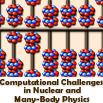Speaker
Kai Neergaard
Description
In 1936, Bethe and Bacher suggested that when the Coulomb
energy is neglected, the masses of nuclei with given mass
number A=N+Z, where N and Z are the numbers of neutrons and
protons, rise from N=Z approximately quadratically in N-Z.
Myers and Swiatecki found in 1966 a marked deviation from
this rule; for small |N-Z| the mass rises more rapidly. They
called the resulting apparent extra binding energy in the
vicinity of N=Z the Wigner energy. It will be shown that this
nonanalytic behaviour of the mass as a function of N-Z arises
naturally when the pairing force is taken into account
beyond a mean field approximation. In the limit of an
equidistant single nucleon spectrum, the symmetry energy,
that is, the increment of the mass from N=Z in the absence
of the Coulomb energy, is proportional to T(T+1), where T is
the isospin, in the ground state of a doubly even nucleus
equal to |N-Z|/2. This expression is similar to the one
which describes the spectrum of a quantal, axially symmetric
rotor, and Frauendorf and Scheikh identified in 1999 the
deformation which gives rise to an analogous rotation in
isospace as the superfluid pair gap. Large shell corrections
modify this bulk behaviour. In recent work by Bentley and
Frauendorf, partly in collaboration with the speaker,
various approaches to the treatment of these shell
corrections are
considered. In one approach the pairing force is
diagonalised exactly in a small valence space. More
recently, the usual pairing correction of the
Nilsson-Strutinsky theory is supplemented with a term
derived from the Random Phase Approximation. The resulting
theory reproduces quite well the empirical masses in the
vicinity of N=Z for A not less
than 24. A very recent generalisation of the method, which
allows its application throughout the chart of nuclides and
also on top of a formalism of the Hartree-Fock type, will be
discussed.

